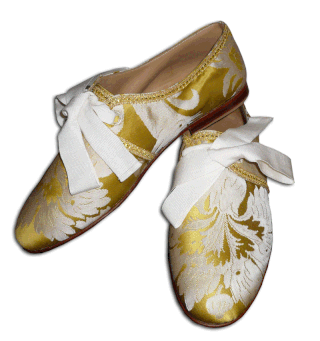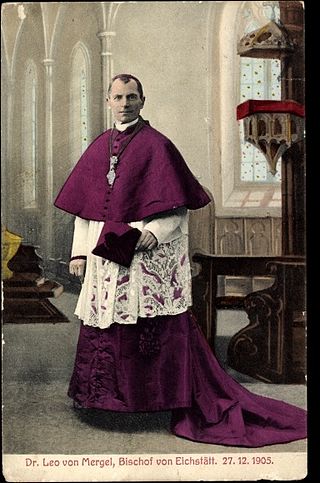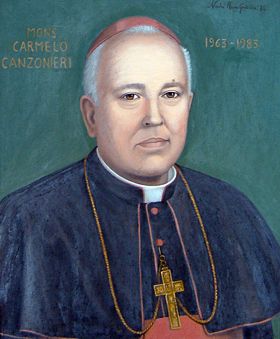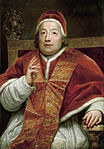
The cassock or soutane is a Christian clerical clothing coat used by the clergy and male religious of the Oriental Orthodox Churches, Eastern Orthodox Church and the Catholic Church, in addition to some clergy in certain Protestant denominations such as Anglicans and Lutherans. "Ankle-length garment" is the literal meaning of the corresponding Latin term, vestis talaris. It is related to the habits traditionally worn by nuns, monks, and friars.

The mitre or miter, is a type of headgear now known as the traditional, ceremonial headdress of bishops and certain abbots in traditional Christianity. Mitres are worn in the Catholic Church, Eastern Orthodox Church, Oriental Orthodox Churches, the Anglican Communion, some Lutheran churches, for important ceremonies, by the Metropolitan of the Malankara Mar Thoma Syrian Church, and also, in the Catholic Church, all cardinals, whether or not bishops, and some Eastern Orthodox archpriests.

The biretta is a square cap with three or four peaks or horns, sometimes surmounted by a tuft. Traditionally the three-peaked biretta is worn by Catholic clergy and some Anglican and Lutheran clergy. A four-peaked biretta is worn as academic dress by those holding a doctoral degree from a pontifical faculty or pontifical university or faculty. Occasionally the biretta is worn by advocates in law courts, for instance the advocates in the Channel Islands.

The zucchetto or solideo, officially a pileolus, is a small, hemispherical, form-fitting ecclesiastical skullcap worn by clerics of various Catholic churches, the Syriac Orthodox Church, and by senior clergy in Anglicanism.

Monsignor is an honorific form of address or title for certain male clergy members, usually members of the Roman Catholic Church. Monsignor is the apocopic form of the Italian monsignore, meaning "my lord". "Monsignor" can be abbreviated as Mons or Msgr. In some countries, the title "monsignor" is used as a form of address for bishops. However, in English-speaking countries, the title is dropped when a priest is appointed as bishop.

A galero is a broad-brimmed hat with tasselated strings which was worn by clergy in the Catholic Church. Over the centuries, the red galero was restricted to use by individual cardinals while such other colors as black, green and violet were reserved to clergy of other ranks and styles.

Papal regalia and insignia are the official items of attire and decoration proper to the Pope in his capacity as the visible head of the Catholic Church and sovereign of the Vatican City State.
The pope's hat may refer to:

The Ring of the Fisherman, also known as the Piscatory Ring, is an official part of the regalia worn by the Pope, who is head of the Catholic Church and successor of Saint Peter, who was a fisherman by trade. It used to feature a bas-relief of Peter fishing from a boat, a symbolism derived from the tradition that the apostles were "fishers of men". The Fisherman's Ring is a signet used until 1842 to seal official documents signed by the Pope. Since at least the Middle Ages it has been a tradition for Catholics meeting the Pope to show their devotion by kissing the ring.

The Papal slippers are a historical accoutrement worn by the Pope. The papal slippers were a form of episcopal sandals worn by bishops. However, unlike the episcopal sandals, which change with the liturgical colour, the papal slippers were always red.

Episcopal sandals, also known as pontifical sandals, are a Catholic pontifical vestment worn by bishops when celebrating liturgical functions according to the pre–Vatican II rubrics, for example a Tridentine Solemn Pontifical Mass.

Papal inauguration is a liturgical service of the Catholic Church within Mass celebrated in the Roman Rite but with elements of Byzantine Rite for the ecclesiastical investiture of a pope. Since the inauguration of Pope John Paul I, it has not included the 820-year-old (1143–1963) papal coronation ceremony.

A cappello romano or saturno is a prelate's hat with a wide, circular brim and a rounded crown worn outdoors in some countries by Catholic clergy, when dressed in a cassock.

Choir dress is the traditional vesture of the clerics, seminarians and religious of Christian churches worn for public prayer and the administration of the sacraments except when celebrating or concelebrating the Eucharist. It differs from the vestments worn by the celebrants of the Eucharist, being normally made of fabrics such as wool, cotton or silk, as opposed to the fine brocades used in vestments. It may also be worn by lay assistants such as acolytes and choirs. It was abandoned by most of the Protestant churches that developed from the sixteenth-century Reformation.

The Papal shoes are the red leather outdoor shoes worn by the Pope. They should not be confused with the indoor Papal slippers or the Episcopal sandals, which are the liturgical footwear proper to all ordained Catholic bishops of the Latin Church.

The mozzetta is a short elbow-length sartorial vestment, a cape that covers the shoulders and is buttoned over the frontal breast area. It is worn over the rochet or cotta as part of choir dress by some of the clergy of the Catholic Church, among them the pope, cardinals, bishops, abbots, canons and religious superiors. There used to be a small hood on the back of the mozzetta of bishops and cardinals, but this was discontinued by Pope Paul VI. The hood, however, was retained in the mozzette of certain canons and abbots, and in that of the popes, often trimmed in satin, silk or ermine material.
Academic dress at the University of St Andrews involves students wearing distinctive academic gowns whilst studying at the University of St Andrews. Undergraduate gowns in Scotland were once common at all the ancient universities of Scotland, with each having its own distinctive style. St Andrews undergraduates wear either a scarlet gown if they are part of the United College and studying in the Faculties of Arts, Medicine and Science, or a black gown if they are part of St Mary's College and studying in the Faculty of Divinity.

The Canterbury cap is a square cloth hat with sharp corners. It originated in the Middle Ages, and is commonly found in the Anglican Communion, as well as in the Catholic Church where it is used by Anglican Ordinariate clergy. It is also soft and foldable, "Constructed to fold flat when not in use ..." The Canterbury cap is the medieval biretta, descended from the ancient pileus headcovering. It is sometimes called the "catercap".

The ceremonial of Benedict XVI (2005–2013) re-introduced several papal garments which had previously fallen into disuse.

The pellegrina is a cape-like item of clerical dress worn by some Catholic ecclesiastics.























